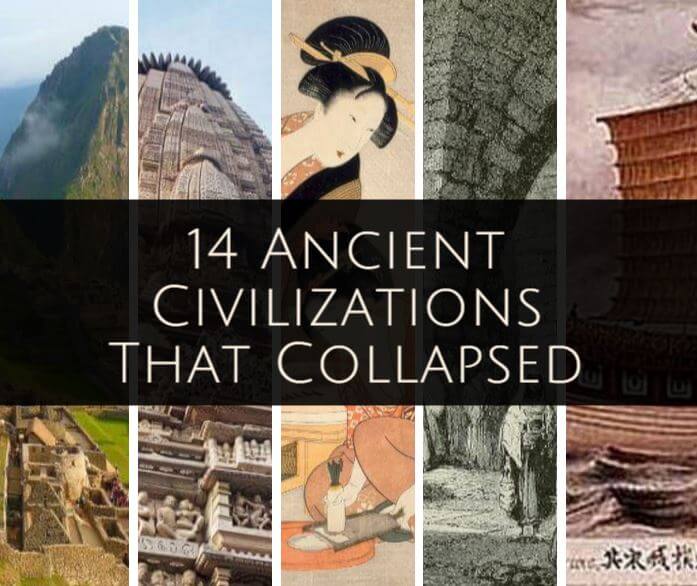In this article, we will discuss some of the greatest ancient civilizations that collapsed. It is important to take into account the civilizations which populated the earth, as these have given shape in great measure to the collective unconscious. The Sumerians as the cradle of civilizations, the Greeks who formed our thought, the Chinese and their inventions, the Hindus and their spirituality, the Persians and Hebrews during their great artistic and scientific splendor. All these are the base of our entire way of living, thinking and acting.
It must be taken into account that the ancient civilizations that collapsed, many of them more than 6,000 years ago, were full of brilliance, with great advances, even being thousands of years older, they would come to be more advanced than Europe in the Middle Ages (from 500 to 1500 A.D.)
So, why these civilizations disappeared and why we know nothing of their splendors?
The reason we do not know anything about these civilizations is that when an empire is established in a region, it completely razes everything that was there before, killing the geniuses, burning scripts and buildings, and finally nothing is left. In addition, history is told by the winners and not the losers. Our culture has been formed by Greek thought, because the Romans who absorbed the Greek culture, have told us its story and the thoughts of its philosophers. It is fitting to note that currently, we have advanced technologically, because we do not destroy the knowledge anymore, we do not burn the texts, well, apparently we do, because the wars in the Middle East are destroying the prints of the Phoenician civilization in Syria, of the Persian civilization in Iran and of the civilizations of Mesopotamia in Iraq.
The best example of an empire which put an end to a civilization is the Spanish empire, which would raze and destroy great ancient civilizations in Mexico, in all of Latin America (and indirectly in Africa), of which we know nothing, and this was a recent event, around 500 years ago, now imagine civilizations 6,000 years ago. We should note that when an empire conquers another, it is not because it is superior culturally, but militarily. The Romans were not superior to the Greeks, the Mongols were not superior to the Asian civilizations, the Spanish were not superior to the civilizations in America, the Turks were not superior to the marvelous Islamic civilization. On the other hand, the sands of the desert and the trees in the forest cover the traces of ancient peoples.
14 Ancient Civilizations That Collapsed
Contents
The great civilizations of the Middle East
1. The Sumerian civilization
Ancient Sumeria was located in what is currently Iraq, whose region in ancient times was known as Mesopotamia, a place located between the rivers Tigris and Euphrates, which were very favorable for living and farming.

Initially, the Sumerians were in Mesopotamia around the year 4500 before Christ, later in this same region, the Akkadian empire arose, which by means of Sargon the conqueror threw itself into the conquest of the Sumerian cities. The Akkadian empire was established in the region from the year 2334 to 2192 B.C approximately. Later another great empire called the Assyrian empire would rise to the north of Mesopotamia (it is from this empire that the winged bulls with the head of a man which we find in the British Museum come), who were bordered to the south by Babylonia. This empire came to be very large, so much so that they were the ones responsible for deporting the Israelites, and that all the tribes of Israel should be lost with the exception of the tribe of Judah. They were present in the area more than 1000 years, from 1813 to 609 B.C approximately. They came to dominate Babylonia, who would later recover independence and rise as a great empire. Babylon was a great city for more than 1000 years, present in the area from 1894 B.C until 539 B.C. Imagine the advances which can take place in a city more than 1000 years old and where they did not have the inhibition of eras like the Middle Ages. For example, the famous tower of Babel was found there (the one from the picture), a building believed to have been 90 meters in height.
The Sumerians invented practically everything: the wheel (3500 B.C), writing (3300 B.C), cities, religions, astrology, laws, schools, agriculture, the first dictionary. They even had beer, cheese, olive oil, among other things. A curious piece of information is that among so many excavations a text was found, in which a father complained that the youth were becoming rebels, and would not obey their parents. In the Sumerian city of Eridu (the garden of Eden) the god Marduk created the world. In a different area, Uruk was the first city, one of the most important centers of the world, and which saw the birth of kings like Enmerkar, the second king of the first dynasty of Uruk, and the king Gilgamesh, who is famous for being the protagonist of the famous epic narrated in the poem of Gilgamesh, in which he meets the wise Utnapishtim (the Biblical Noah), who tells him how he survived the flood sent by the god Enlil.
Abraham, the father of the Hebrews and the Muslims, left from Ur of Sumeria and his story is narrated in the famous writing called: “Genesis.” Sumeria is also the cradle of pagan gods, and if you compare the gods of the ancient Sumerian mythology, you will realize that they are very similar to the gods of the Greek mythology. There are few records of this ancient culture, due to the fact that its buildings were made of baked clay, which were used until recently in some buildings, and as you know, clay is not a material which lasts in buildings for thousands of years.
2. The Persian civilization
It is important to clarify that of the Middle East, the Persians are not Semitic. The peoples who speak a Semitic language, and who correspond to the rest of the countries of the Middle East are called Semitic. The term comes from the Bible, from Shem, the son of Noah, from whom a series of peoples in the Middle East would rise.
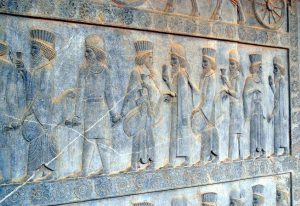 After the empires of Mesopotamia, it would be the turn of the Aryans. The last empire in Mesopotamia would fall under the power of their neighbors the Persians (modern-day Iran), who are also called Iranians – Aryans. Some histories say that the current human race is the Aryan, the anterior was the Lantian, and the next will be the Koradi. The case is that from here arose the prophet Rama who took the Veda culture to India and on the other hand Hitler and the Germans who claimed to be descendants of the Aryans. It is believed that the swastika is one of the oldest symbols of the Aryans, which represents Brahma, Vishnu, and Shiva, the trinity of the gods of Hindu mythology, which seems much like the trinity in Christian mythology. From the Persians, the first monotheistic religion in the world also arose, which was Zoroastrianism, in which it is spoken of one true god Ahura Mazda, who fights against the evil one, who is Ahriman, and this religion would displace the cult of Mithra.
After the empires of Mesopotamia, it would be the turn of the Aryans. The last empire in Mesopotamia would fall under the power of their neighbors the Persians (modern-day Iran), who are also called Iranians – Aryans. Some histories say that the current human race is the Aryan, the anterior was the Lantian, and the next will be the Koradi. The case is that from here arose the prophet Rama who took the Veda culture to India and on the other hand Hitler and the Germans who claimed to be descendants of the Aryans. It is believed that the swastika is one of the oldest symbols of the Aryans, which represents Brahma, Vishnu, and Shiva, the trinity of the gods of Hindu mythology, which seems much like the trinity in Christian mythology. From the Persians, the first monotheistic religion in the world also arose, which was Zoroastrianism, in which it is spoken of one true god Ahura Mazda, who fights against the evil one, who is Ahriman, and this religion would displace the cult of Mithra.
Mithra, an Aryan deity, also formed a part of the Hindu mythology. In another area, Mithraism was one of the strongest religions in the Roman empire, it had different levels of initiation, and the principal rite of the Mithraic religion was a banquet very similar to the Christian Eucharist. Many say that the story of Jesus is taken from this same god Mithra, as they have too many points in common. Both were born of a virgin, both had disciples, both were crucified and all other quantity of similarities which makes it seem as if they were the same. Manichaeism also arose in Persia, founded by the Persian Mani (born in 215 A.D) who claimed to be the last great prophet sent by God.
The Persian empire had its great splendor with the dynasty of the Achaemenids, with Cyrus the Great and Darius I the Great. This empire was so large that it came to extend to Europe, and was only stopped by the Athenians around 555 B.C. Later when the Macedonian Alexander the Great conquered the world around 350 B.C, the Persian culture fell under his dominion, and in addition he destroyed the capital of the Persian empire, Persepolis. Later when Alexander died, this Persian region would be governed by one of his generals named Seleucus, who would found the Seleucid dynasty, which would establish Greek thought.
The Persians would come to have another great splendor with the dynasty of the Sassanids, which was an empire from 226 to 651 A.D. The Sassanid kings were defenders of the knowledge of ancient times, so much that when the Roman emperor Justinian (who converted the Roman empire to Christianity), closed the schools of Athens, many of its scholars fled to Persia. Under the dynasty of the Sassanids, in the 4th Century, the college of Gundishapur was founded, which became the greatest intellectual center of the world, to which students from the whole world came. Art was one of the great representatives of this culture, achieving precious sculptures, paintings, and textiles.
The empire of the Sassanids would fall under the power of the Muslims, who would also establish another great center of civilization with the Abbasid Caliphate, as these Muslims absorbed much of the knowledge of the marvelous Persian culture. The Persians would finally remain Shiite Muslims, which are those who follow Ali (the son-in-law of Muhammad) and his descendants, and are differentiated from the Sunni majority who do not recognize this succession and instead named Caliphs, which are like administrative positions. The Persians are to the Muslims what the Greeks were to the Romans, and in this way, when the first Muslims came, they would absorb all the Persian splendor. For example the book: “The Thousand and One Nights,” is a compilation of Persian stories, which would be translated into Arabic by the Muslims.
After the Muslim invasion and the Abbasid Caliphate having flourished, the Persians again fell under an invasion, this time of Turks coming from central Asia, who would form the Seljuk dynasty (not to be confused with the Seleucid dynasty) between the 11th and 13th Centuries. These Turks would convert to Islam and would form an empire which would protect the Muslim world from the Mongols and from the Byzantine Empire. They would finally end up falling under the dominion of the Mongols. The Mongols, even though they did destroy a great part of the civilization, would again form another empire under the mandate of Tamerlane, who would go as far as conquering part of Syria and even part of India. A show of just how great this empire created by Tamerlane came to be, we find in the marvelous city of Samarkand, located in what is today known as the country of Uzbekistan. Finally, the last great Persian empire was the empire of the Safavids which began as a Sufi order and which later with Shah Ismail I in 1501 would found the Safavid dynasty, which lasted until 1722. Ismael was a defender of the Shiite faith and would establish it in the entire empire, he converted the city of Isfahan to the capital of the empire, and this would come to be a marvelous city full of splendors and luxuries.
Finally, all Persian splendor continued gradually disappearing because of the expansion of different empires, the Tsarist empire in the north, the Turkish empire in the east, and the British empire from India.
3. Civilization of the Canaanites
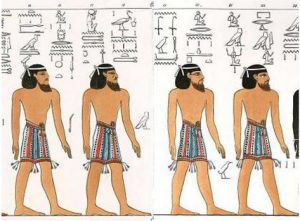 They correspond to current Syria and Lebanon, which for a time were known as the Phoenicians, the great merchants of ancient times, and who created the Carthaginian empire, who were great rivals of the Romans. If Carthage had defeated Rome, then the base of worldwide cultural would not be Greek, but Phoenician and the gods we worship would not be those of Christian mythology (which are the same as those of Zoroastrianism), but those of the Phoenician mythology.
They correspond to current Syria and Lebanon, which for a time were known as the Phoenicians, the great merchants of ancient times, and who created the Carthaginian empire, who were great rivals of the Romans. If Carthage had defeated Rome, then the base of worldwide cultural would not be Greek, but Phoenician and the gods we worship would not be those of Christian mythology (which are the same as those of Zoroastrianism), but those of the Phoenician mythology.
For a long time, Lebanon was called the Pearl of the Orient, a city full of luxuries, which would contain in itself the prints of all the empires of ancient times. It is a city where diversity could cohabit, where different cultures were respected, like the Roman, Persian, and the Muslim. There we find many relics of the Phoenician civilization like jewelry, pottery, relics. All the splendor of Lebanon was destroyed in the recent wars in the Middle East. There are still some vestiges in the National Museum of Beirut.
4. The marvelous Islamic Civilization and Culture
 Around the year 575 Muhammad was born, founder of Islam. At forty years old Muhammad, through entire days in a cave, believed he received revelation from Allah, who spoke to him through the archangel Gabriel and communicated to him the true faith. It can be said that the gods of the Muslims are the same as those of the Hebrew mythology. Later he started what would be the holy war with the purpose of converting the infidels. On the death of Muhammad, the Muslims divided into two currents. The Sunnis, who follow some additional verses of the Koran and appointed administrators called Caliphs, are differentiated from the Shiites, because these last follow the son-in-law of Muhammad and his successors, and do not recognize the additional verses.
Around the year 575 Muhammad was born, founder of Islam. At forty years old Muhammad, through entire days in a cave, believed he received revelation from Allah, who spoke to him through the archangel Gabriel and communicated to him the true faith. It can be said that the gods of the Muslims are the same as those of the Hebrew mythology. Later he started what would be the holy war with the purpose of converting the infidels. On the death of Muhammad, the Muslims divided into two currents. The Sunnis, who follow some additional verses of the Koran and appointed administrators called Caliphs, are differentiated from the Shiites, because these last follow the son-in-law of Muhammad and his successors, and do not recognize the additional verses.
The Islamic culture extended to all of Asia and a great part of Europe, razing a great part of the peoples that were there, when they reached the Persians, they received their civilizing influence. If any vestige of the Persian civilization is left, it is through the Muslims, and it is owing to this that the Islamic civilization flourished. As we heard in the program Cosmos: “In the era of scientific splendor of the Islamic civilization, the Christian and Jewish scholars were guests of honor in the centers of investigation in Baghdad and Cairo. In place of burning books, the Caliphs sent emissaries around the world in search of books.”
From the Muslim civilization the physicist Ibn al-Haytham arose, the first person to establish the rules of science, who discovered the scientific method, a systematic way to filter the mistaken ideas of our thoughts: “Finding the truth is difficult, and the path to it is arduous, as searchers for the truth it would be healthy not to issue a judgment, in place of simply trusting in the writings of the ancients, one should question and critically examine these writings from all the angles, and should submit themselves to to the arguments and experiments and not to what any person says because all human beings are vulnerable to all kinds of imperfection, as searchers for truth we should also suspect and question our own ideas as we conduct our investigations to avoid falling into prejudices or careless thoughts.”
Two great Caliphates arose from the Muslim civilization. In the first place, the caliphate of Cordoba, in Spain, and that thanks to them, the Europeans got to know the thought of Aristotle, and developed great advances in mathematics and physics. They were great until the Christian part of Spain persecuted them and finished them off. Later we have the Caliphate of the Abbasids in Baghdad, the capital of Iraq. It was there that the age of greatest splendor and discovery happened, the cradle of great inventors, who left to us things like: Distillation, valves, uric acid, locks, evaporation, the check, rockets, the torpedo, shampoo, etc. They were great until the Mongol empire destroyed them and only left dust. Imagine how many geniuses, how many texts, how many buildings were not destroyed.
Around the year 1300 another empire arose in the south of Europe, they were the Ottoman Turks, who would assume the Muslim religion and extend it throughout their empire, with some light changes. Now the monarchs were not Caliphs, but Sultans. Now they were not Caliphates, but Sultanates. The problem lies in the fact that the Turks were not a civilization, thus the only thing they left us of the marvelous Muslim civilization was the religious dogma. To finish coming to an agreement, when the Ottoman Empire fell, the English and French divided the region in the Sykes-Picot agreement, which would form the current countries. Said borders are completely arbitrary, made with the goal of dividing up oil wells. For example, the country of Kuwait, belonged to what is currently Iraq, but as it was a petroleum zone they made it into a separate country. Later we would see that Saddam Hussein would try to recover this territory in the famous Persian Gulf War.
5. The Nation of the Hebrews
The Ancient Hebrews are called thus because of Abraham, who abandoned the land of his fathers, Ur of Chaldea (in Mesopotamia) to go to Canaan by order of God. Let us remember that initially the 12 tribes of Israel were taken by the Assyrian Empire to Nineveh, the Assyrian capital, where these tribes would be dispersed and only the tribe of Judah would survive, and because of this the Hebrews are known as Jews. The Jews also resisted worshiping Roman gods, and because of this were expelled from Israel by the Romans towards the year 70 A.D, and these went to settle in Europe. And finally, they were persecuted by the Nazis.
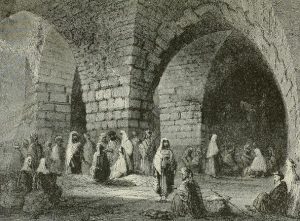 Abraham followed the ancient Sumerian gods, but it is very probable that after getting to know Persian monotheism, he converted to a monotheistic faith, as Genesis relates. It is known that Genesis is a compilation of ancient Sumerian legends. It is said that Abraham, upon meeting monotheism, received a sacred knowledge, called Kabbalah, which is an oral tradition which is transmitted from ear to ear among the Jewish community.
Abraham followed the ancient Sumerian gods, but it is very probable that after getting to know Persian monotheism, he converted to a monotheistic faith, as Genesis relates. It is known that Genesis is a compilation of ancient Sumerian legends. It is said that Abraham, upon meeting monotheism, received a sacred knowledge, called Kabbalah, which is an oral tradition which is transmitted from ear to ear among the Jewish community.
The reason for which for many years there has been a war between the Palestinians and Israelis is due to that fact that when the Jews were expelled from their territory, this was occupied by the Palestinians. After the Jews were nearly exterminated by Hitler, they endeavored to return home and have a place to live. Owing to a gesture of solidarity with the Jewish community, the British Empire after the end of the Second World War, promised them that they would have their original land. On arriving there, they dislocated the Palestinians, who fight to return to the territory which for nearly 2,000 years belonged to them.
Jerusalem, the capital of Israel, is supremely important for being that base of the three monotheistic religions. It is the Holy City for the Jews because there the Temple of Solomon is found, center of Jewish devotion, it is also a Holy City for the Christians, because there many of the events in the life of Jesus took place, and it is a Holy City for the Muslims because there Muhammad, accompanied by the angel Gabriel, ascended toward the throne of God.
The Great Ancient Civilization of Asia
1. Chinese Civilization and Culture
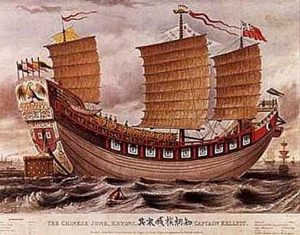 The Ancient Chinese were the cradle of great inventions, only that they were not a conquering empire, it is because of this that their culture always remained there for them. To the Chinese, we owe printing, the compass, gunpowder, porcelain, the kite (The first flying artifact, more than 3,000 years ago), the abacus (the first calculator), and a long etc.
The Ancient Chinese were the cradle of great inventions, only that they were not a conquering empire, it is because of this that their culture always remained there for them. To the Chinese, we owe printing, the compass, gunpowder, porcelain, the kite (The first flying artifact, more than 3,000 years ago), the abacus (the first calculator), and a long etc.
This marvelous culture was flattened by the Mongols, who finished off the great civilizations of Asia. Another great blow that China received, was on the part of the British Empire. Let us remember that the British conquered India, and also wanted to conquer China, and began to approach with the excuse of wanting commerce with them. As China did not want to do business with England, the English began to sell them smuggled Opium, generating a great addiction in the Chinese. The Chinese authorities on seeing this fact protested to England, and they responded to them with a war in which they took Hong Kong from them. Later came the entrance of the Japanese Empire, who finished them off, and who stayed there until Japan was obligated to surrender owing to the atomic bombs. This situation forced many Chinese to leave their country and they went all over the world.
It seems curious, but a great part of the destruction of the Chinese culture was by themselves. First by the Chinese emperor Qin Shi Huang, who around the year 221 before Christ, with the goal of unifying China, prohibited schools of thought like Mohism, and also the first indications of scientific thought. Finally, the Chinese culture ended up leveled by the arrival of Communism, which arose as a response to the miserable situations in which they had been left after the invasions by the British and Japanese. Mao dressed them all equally, had them eat rice and other measures which solved much of the Chines misery; but it brought a great cost in life by the Communist purges attributed to Mao as one of the great genocides of history. In addition, the Chinese Communists were atheists and destroyed a great part of the civilization of their ancestors because they considered it decadent. In this way, from all the Chinese culture which was seen in the movies, we pass to what is now this powerful country. China is the workshop of the world, and by its cheap labor, all the multinationals have their things made there, only that China copies this technology and makes its own products, selling them more economically.
2. The Hindu Civilization and Culture
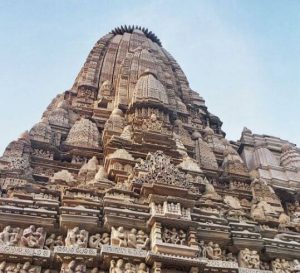 If it can be said of any culture that it survived the passing of the empires it is precisely Ancient India, and it is because of this that we all in some way know of India and its spirituality. This is no other ancient culture which has this merit. In addition, it was the only nation in the world which was decolonized from the English Empire without using violence, thanks to Gandhi inviting his people to use nothing of the English, civil disobedience and to not respond with violence to any aggression.
If it can be said of any culture that it survived the passing of the empires it is precisely Ancient India, and it is because of this that we all in some way know of India and its spirituality. This is no other ancient culture which has this merit. In addition, it was the only nation in the world which was decolonized from the English Empire without using violence, thanks to Gandhi inviting his people to use nothing of the English, civil disobedience and to not respond with violence to any aggression.
It is believed that on the banks of the Indus river existed an ancient and disappeared civilization called Mohenjo-Daro around 2600 B.C and it was the most developed city in Asia, with wells and advanced drainage systems, with a sewage system, and in addition streets paved with mortar of bits of brick, and its activities were agricultural and commercial.
In another area, legend says that the prophet Rama, who left us the Veda culture, left what was Persia and settled in India. The Veda culture was able to survive the passing of time and is among the few things which we can still know about ancient civilizations that collapsed. The same would happen with Buddhism, and the two have spread as an alternative to the monotheistic beliefs of this time.
As you know the British Empire governed practically the whole world, had a presence in America, Africa, and of course, the Hindus were dominated by the English. This is the reason by which we know about the Hindu culture, on themes like meditation, yoga and Oriental philosophy. The English arrived there, colonized them, and they later became independent without the use of weapons, thanks to the presence and leadership of Gandhi. Gandhi led his people to independence with civil disobedience, in which they did not confront them, but neither did they obey them. The most curious thing is that when the Second World War erupted and England had to face Hitler practically alone, Gandhi suspended the process of independence for India, because he said it was not honorable to face an enemy when they were weak.
3. The Japanese Empire

Ancient Japan was a marvelous culture which owes its peculiarities to the fact that they are an island and on the other hand were isolated from the world for a large period, in which no one was permitted to leave nor enter Japan, nor have a commercial exchange. In this period the Samurai, the ninjas, the Geishas, and all these peculiarities of its culture arose in Japan.
All this isolation came to its end, when Commodore Perry (of the British Empire), at the command of 10 modern ships, arrived in Tokyo in 1853 and obligated Japan to open itself to the world again. This put an end to the Edo period, and produced the transition from feudalism under the mandate of the shogun, and beginning the Meiji era. During the Meiji period, Japan began its modernization, setting itself up as a world power. During the Meiji period telegraph cables were made, construction of railways, mines, textile factories, etc. All this completely destroyed all the old and rich Japanese culture.
Japan became a great empire in a short time, which expanded to Asia, and the Pacific and Indian oceans, a period in which it subdued India, Korea and the rest of Asia, save Vietnam committing all kinds of atrocities. Its empire came to an end when in the Second World War, the United States invented the atomic bomb and dropped it on Japan, producing their unconditional surrender.
The Great Ancient Civilizations of The Americas
There exists a strange tendency to think that the Native Americans were primitive people who did not think, only because of the fact that they had not invented weapons of mass destruction, or because many tribes remained half-naked, because for the hot climates it was not necessary to dress as much as it was for the Europeans. Of course for the Christian Puritanism of the time, this was a scandal. On the other hand, it must be taken into account that when it comes to a certain place, it is not necessarily the most advanced civilization, it is like if you went to Asia and arrived in Australia instead of China, it is not the same.
It must be understood that the mind of the human being has the same capacity for learning in China, in Europe, and in the Native Americans. The mind of these natives possessed the capability of having a cosmogony, a culture, and a technology as complex as any other culture. They constructed architectural works like the pyramids, which was the only thing which remained because they are something that cannot easily be burned. To make a pyramid it is necessary to know mathematics, and if they knew of mathematics, they could also know about medicine and other things. When the Spanish arrived, they considered that the natives did not have a soul, the same as what happened with the Africans, thus they thought that nothing they saw had any importance, and they burned it. Who knows what records of ancient civilizations in America were burned, what advances achieved by these cultures were destroyed, what texts with the philosophies of great geniuses burned in the flames.
From among the indigenous tribes, certain tribes are still conserved which even remain intact and with a very advanced culture, for example, the Arawak Indians, in the Sierra Nevada of Santa Marta, to whom many persons come from different areas to listen to their ancient teachings.
1. The Inca Empire and Civilization
 The Inca Civilization had its origin in the Valley of Cuzco (Peru) around the 11th Century and came to cover a great part of South America, from Colombia to Chile. The Inca society was divided among nobles, who did not have to work the ground, and the other was the general population.
The Inca Civilization had its origin in the Valley of Cuzco (Peru) around the 11th Century and came to cover a great part of South America, from Colombia to Chile. The Inca society was divided among nobles, who did not have to work the ground, and the other was the general population.
The nobles could have more than one wife, wore fine clothing, bathed in fountains with hot water, and their education was charged to wise men who prepared them to be governors, warriors or priests. All obeyed the supreme chief who was considered a living god, and to disobey him was to be submitted to punishment from exile to death.
The Incas represented the world with a phrase, “Outside of the Incas nothing existed, because nothing should have existed,” and it is because of this that nothing was said of the previous cultures, neither was anything said of the conquered cultures. We do not know if before the Incas or the peoples conquered by them could have had marvelous cultures. They did not leave traces of ancient civilizations, and later the Spanish did not leave traces of them.
2. The Mayan Empire and Civilization
The Mayas were a prosperous civilization in Central America from approximately 1000 B.C until 900 A.D when their decline began, due to internal wars and ecological changes. It is because of this that when Cortes reached the coasts of Mexico, the Maya civilization had disappeared several centuries before.

Numerous city-states arose in the jungle, constructing colossal stone monuments and developing a scientific and artistic culture which competed with the most advanced of Europe and Asia. The kings led their men to war in the name of the gods. They practiced human sacrifice with the slaves from their conquests, to pay a debt of blood which the people had incurred at the time of creation.
Their pyramidal constructions are the most remarkable thing about them, as they did not have beasts of burden or metal tools. They possessed great mathematical and geometrical knowledge with which they constructed great cities, and we do not know if said knowledge would have been a great contribution to the modern world because the arrival of the Spaniards erased everything.
The great civilizations and empires of Africa
We do not know much of the ancient civilizations of Africa because of various factors, one because of their language different from Latin, another because for a very long time they were submitted to slavery and European colonialism, and last, because they currently live only in war. In these wars European colonialism returns and plays as a cause, which split up the whole African continent, it is because of this that on seeing a map of Africa we see that its borders are not natural but the product of the trace of a ruler.

Africa was split up by the Europeans in the conferences of Yalta and Potsdam. Let us imagine that in the meeting, for example, a European power said that in the agreement they wanted a lake, a mountain, and a mine inside their country, and based on this desire, they took a ruler and grouped in one territory a little of each thing. This is the cause of the wars in Africa. This distribution has nothing to do with the cultures contained therein, that is to say, that within the same nation, tribes were contained which before had been rivals, who today fight for power. Apart from this, after Europe colonized them, they stole all their resources and left them with nothing. In this process of European decolonization, the powers who were fighting the Cold War took advantage in selling them arms and feeding off the conflict. Today Africa is an area full of hunger and weapons.
From Africa arose one of the great leaders of the modern era, Nelson Mandela, who spent 27 years in prison for defending the rights of the black community. It was told to Nelson Mandela that if he renounced his fight, they would set him free, and he preferred to stay in prison rather than renounce his principles. Later Nelson Mandela would be freed and would become the president of South Africa.
Africa was not always the continent we see today. There was a time they had before the arrival of the Europeans in which they were great, with great resources and great civilizations in its interior. All this was erased thanks to centuries of slavery which finished off its culture, as people, priests and kings were taken equally from their region and later taken as slaves to America. On the other hand, the cultures which existed before the empires which were there at the arrival of the Europeans are known very little; because they had already been conquered by the Muslims. Let us take into account that the most ancient hominid (with the capacity to walk upright, endowed with intelligence and manual ability) was found in central Africa, 7 million years old. In addition, because of being a black continent, European archaeologists were not very interested in excavating civilizations in the sands of the desert.
1. Songhai Empire
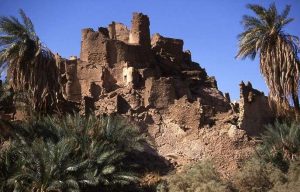 It was a state in the west of Africa, and at the hands of the first emperor, Sonni Ali around 1460 conquered many neighbor states, coming to raise an empire as large as that of Charles the Great, covering 1.4 million square kilometers. Ali was a Muslim and because of this the justice system and the government were based on Islamic principles. Ali was a formidable military strategist, who achieved the largest empire in Africa. In many African stories, he is described as a tyrant, who burned cities and killed brutally.
It was a state in the west of Africa, and at the hands of the first emperor, Sonni Ali around 1460 conquered many neighbor states, coming to raise an empire as large as that of Charles the Great, covering 1.4 million square kilometers. Ali was a Muslim and because of this the justice system and the government were based on Islamic principles. Ali was a formidable military strategist, who achieved the largest empire in Africa. In many African stories, he is described as a tyrant, who burned cities and killed brutally.
In the city of Timbuktu in Songhai, a cultural and commercial center for Arabs, Italians, and Jews developed. The center of its economy was gold, handicrafts, salt, leopard skins and slaves. A person’s occupation was dependent on their clan. The ground was very fertile, and its agricultural activities were carried out by slaves on the properties of aristocrats, who lived luxuriously.
2. The Kingdom of Benin
Benin was a kingdom which corresponded to what is now Nigeria, and they initiated commercial relations with the Portuguese towards the 15th Century.
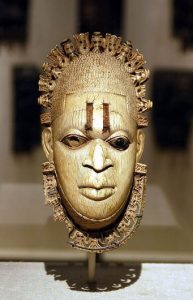
The kingdom of Benin developed a complete sculptural art in materials like bronze, iron, marble, ceramics and wood. They also developed statues, masks, divine representations and musical instruments. The kings were endowed with supernatural powers and because of this remained isolated from the people. Inside the capital, there was a great avenue which separated the palace from the rest of the city, and it was surrounded by a walled enclosure. In it, there were neighborhoods which lodged numerous corporations of artisans. The city was large and contained streets with thousands of adobe houses. Currently, no trace is left of these cities due to the climate and its materials no being very resistant like stone. What is known of ancient Benin, we do from a Dutch traveler in the 16th Century who described the city.
3. The marvelous Egyptian civilization and culture
To talk about the marvelous Egyptian culture, there is much documentation and it is much better known than any of the civilizations we have mentioned. In addition, it was very related to the Roman Empire, which would end up conquering and destroying it, with the exception of the pyramids, as obviously, it is not easy to do away with a pyramid. In contrast to the civilizations of Mesopotamia, the Egyptian civilization did not endure invasions nor destructions for a long period of time.
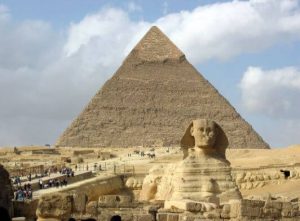
In Egypt, the marvelous library of Alexandria would be constructed, which would compile all the knowledge of Ancient Times. There, great scholars would concentrate, and there, books would be brought from different parts of the world, which would contain all the knowledge of Ancient Times on the scientific level, the medicinal, and many other arts. Later this marvelous library would be burned by fanatic Christians, as and how it is seen in the movie Agora. It sincerely makes on want to cry when one sees how they burn this library.
Much of the Egyptian culture was saved by Napoleon, a man who know what it was he stood before, and because of this his famous phrase on seeing the pyramids: “Soldiers. From the height of those pyramids, 40 centuries contemplate us.” Thanks to Napoleon’s expedition to Egypt, the “Rosetta Stone” could be found, and it is thanks to this that what the hieroglyphics mean could be understood.
Nok civilization and culture
This civilization inhabited what is currently Nigeria, which prospered around the year 500 before Christ. It is known that they had carts drawn by horses and that they had developed advanced techniques of mining, agriculture, pottery and the metallurgy of iron. In addition, their social structure was of the most advanced of the time.
The Land of Punt
It existed in ancient times around the year 2450 before Christ and was located in what is now Somalia. We know of them by what is described in the hieroglyphics of Ancient Egypt, as the Egyptians had commerce with them. According to the texts, the skin of the indigenous people of Punt was red.
Europe and the Greek civilization
The marvelous Greek philosophy and mythology
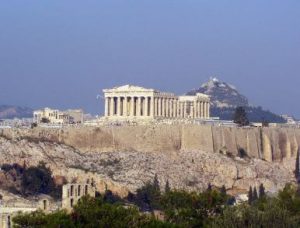
The Ancient Greeks are the base of all our culture as we know it, save some parts of culture which were saved like in the case of India. We know that part of the Greek culture, they received from the Sumerians, like for example their mythology and their system of gods. The Greeks were great for their philosophy which they gave form to as how we conceive of life today. The Greeks would meet in different locations, and instead of talking about whatever theme, they would wonder about life, reflect, and from all their answers arose all the mathematical sciences, psychology, arithmetic, philosophy, theology, etc, as we know them today. From there great thinkers arose, who were philosophers, mathematicians, and theologians in their turn, as were the Greek philosophers Pythagoras, Socrates, Aristotle, Plato, among others.
In another area, the Greek mythology is widely known, and we know that there exists a great similarity between the gods of the Greek mythology and the gods of the Sumerian mythology. Later when the Romans conquered Greece, they would take the same Greek gods, but with different names.
The expansion of the Greek culture through the entire world
When the Roman Empire expanded and conquered Greece, it absorbed all of its splendor; later, when Rome expanded to the rest of the world, it would destroy civilizations in its way (for example the Persians and the Egyptians), and would impose Greek thought in the beginning, and later on the Christian religion. With this type of ideas Europe has been formed, and later when they discovered other civilizations in Africa, America and Asia, they called these types of knowledge superstition. For example, the curative methods of India, like Ayurveda is superstition and pseudoscience, while that which rose in Europe is science and true civilization.
Stage 1: Alexander the Great
In the beginning, when Alexander the Great (330 B.C approx.) conquered the world, he took the Greek culture to all corners, in a process called the Hellenization of the ancient world, let us remember that Alexander the Great was a disciple of Aristotle. On the death of Alexander, his generals divided up the world, being left with the ancient empires. For example, the Egyptian empire passed into the hands of Ptolemy forming the last Egyptian dynasty of the Ptolemies, and the Persian empire passed to the hands of Seleucus forming the empire of the Seleucids.
Stage 2: The Eastern and Western Roman Empire
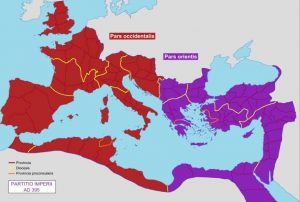 With the birth of the Roman Empire, this empire conquers Greece and absorbs all its culture. It takes the Greek culture to the whole world, finishing off the Egyptian dynasties, the Persians, the Jews, the Phoenicians. Later when the Roman Empire divides in two, the Eastern Roman Empire comes to be the Byzantine Empire, which lasted until the Russian revolution before the First World War. Let us remember that the Byzantine Empire or the Eastern Roman Empire moved to Russia after the Ottoman Turk empire attacked them.
With the birth of the Roman Empire, this empire conquers Greece and absorbs all its culture. It takes the Greek culture to the whole world, finishing off the Egyptian dynasties, the Persians, the Jews, the Phoenicians. Later when the Roman Empire divides in two, the Eastern Roman Empire comes to be the Byzantine Empire, which lasted until the Russian revolution before the First World War. Let us remember that the Byzantine Empire or the Eastern Roman Empire moved to Russia after the Ottoman Turk empire attacked them.
Stage 3: Napoleon and Catherine the Great
The Eastern Roman Empire would assume Orthodox Christianity and the Western Roman Empire would assume Catholic Christianity. When the Western Roman Empire became Catholic all of Europe was submerged in this long Medieval dream, where only the Christian faith explained what existed, and all power was for the Roman Catholic Church. This came to its end first with the Renaissance, and later with the Enlightenment when Europe returned to taking into account the ideas of the ancient Greek philosophers. These ideas of the Enlightenment were taken to all of Europe by Napoleon, and later to Russia and the Byzantine Empire (Eastern Rome) by Catherine the Great.
Stage 4: Colonization by Spain, France, and England
With the discovery of America, Spain would bring the Greek culture to America, and England and France would charge themselves with taking it to the rest of the world. The same processes of colonization and independence which we endured in Latin America at the hands of Spain, the rest of the world endured at the hands of the British and French. The English brought us the Industrial Revolution, where machines changed the way of life, as the strength of men was no longer necessary for production. The French brought us the French Revolution, in which power would no longer be in the hands of monarchs nor the faith, but in the hands of governors chosen by the people. The processes of colonization brought us the Christian faith, the use of machines, firearms, and the concept of nations.
England was for a long time the one who ruled the world, it is said that at the end of the 19th Century, one of every three inhabitants of the world was a subject of Queen Elizabeth. England came to have much power, because there the Industrial Revolution began, in which the machines which were invented would be capable of producing many more things in a faster way, this would begin to create the concept of work as we now know it, as the previous method of working was in the homes of families, and after the Industrial Revolution it would be in factories. The power of England was absolute (later this power would be displaced by the United States, which boomed during the technological revolution), and therefore they made sure to do all that needed to be done to maintain power. One of these examples refers to Alchemy, which was one of the obscure and esoteric arts of ancient times, in which many scientists dedicated time to its investigation, among them the famous Newton, who with his laws form the very base of modern science. The fact is that alchemy promised the transmutation of metals into gold, and as these types of ideas were dangerous for the economy and the dominion of British culture, they prohibited its practice with exemplary punishments, including the gallows.
Conclusions regarding the great civilizations
Great were the civilizations which existed in the world, of many of which we will never know anything, due to the passing of an empire; this destroys everything, implants its culture and considers pagan all that does not belong to it. It is believed that current man has an age of about 195,000 years, and the Sumerian civilization, which is the oldest that we know of is about 5,000 years old, and they had great inventions, so we do not know from there back what else happened.
Archaeological excavations have confirmed to us the existence of cities like Troy, which appeared in Homer’s books, and which was an object of numerous legends. There is also Noah’s Ark, which is recorded in one of the ancient Sumerian stories. Some part of the wisdom of ancient times was compiled in the library of Alexandria, which in the beginning of the Christian faith was destroyed by fanatic Christians, and because of this, we do not know what wisdom they could have found in those books.
In the present day, the culture of which we know the most is the European because they have told it to us and it is the only one which was preserved intact through time. The only wisdom we inherited was that of the Greeks, through the different stages of expansion of the empires which carried its knowledge. The monotheistic religions (whose base is the ancient Persian religion of Zoroastrianism) like Judaism, Christianity, and Islam, and whose center of Faith is found in Jerusalem, were religions expanded by the Roman Empire and by the Turkish Empire, all the other beliefs were considered pagan or of infidels. When Europe became the center of civilization, then all the knowledge of ancient times and all culture which was not European was considered superstition, sorcery, or witchcraft.
In the present, the only wisdom from ancient times, outside of the European, which is still preserved is that of India, and because of this the knowledge of the Vedas, yoga and Buddhism have come into our hands. We do not know what other kinds of wisdom we would have been able to learn from the Persians, from the African and American cultures; it would have been interesting to see other points of view, other ways of interpreting and organizing the world.

